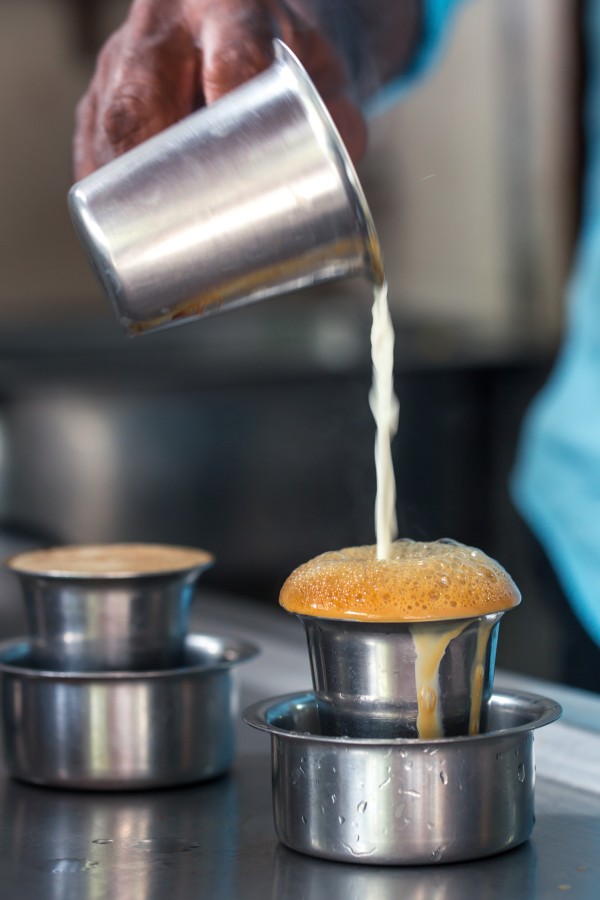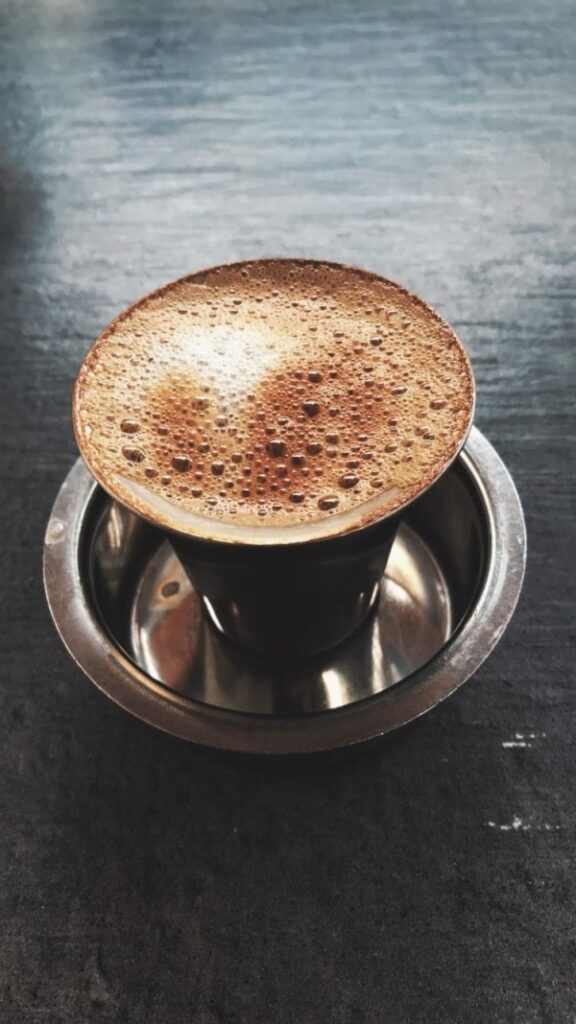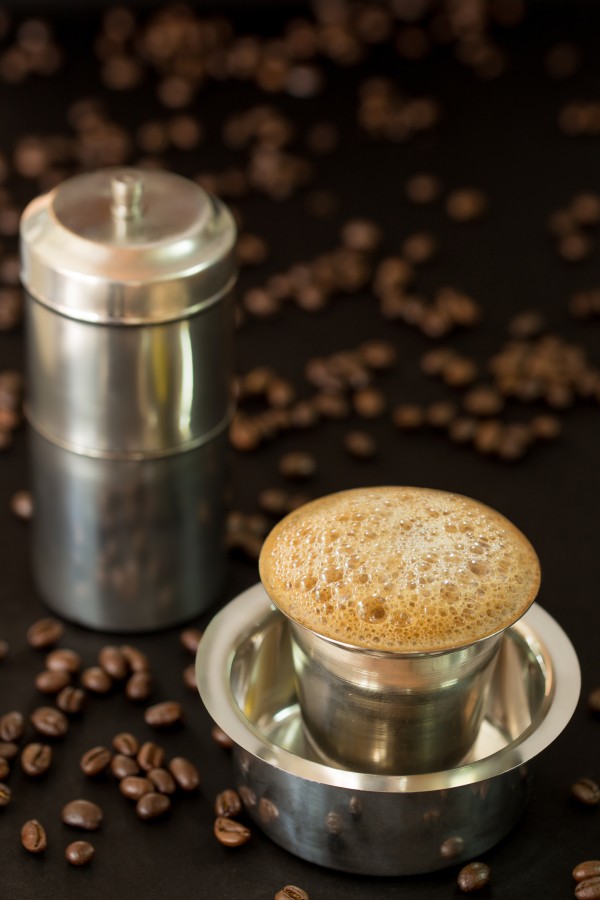It’s the crack of dawn, and the tranquil lanes of Bangalore are gearing up for the incoming hustle and bustle. Along with the rays of sun that seep through the canopy of trees, the whiff of freshly brewed filter coffee, commonly referred to as filter kaapi, infiltrating the air marks the beginning of the day.
While studying in Bangalore, filter kaapi became my sole source of caffeine owing to its potency and affordability. A trip to the coveted neighbourhood Darshini, an eatery serving all-day breakfast and other South Indian vegetarian delicacies, easily fell into my morning regime. I was one of the thousand patrons visiting this institution regularly for golden dosas, crispy vadas, fluffy idlis and, of course, the pièce de résistance, a strong cup of coffee served in a dabara set (brass tea cup and tumbler).

How did the tea-loving nation inculcate coffee into their daily life?
The answer dates to the 16th century when Baba Budan, an Indian Sufi saint, chanced upon these aromatic beans in Yemen during his pilgrimage to Mecca. The Arabs safeguarded these beans to maintain a monopoly of the growth and export and sold them only in their roasted form, disabling buyers from growing coffee on their home grounds. The Sufi saint is claimed to have smuggled seven coffee seeds to India, with his beard as the vessel. He then planted them in the Chandragiri hills of the Western Ghats, where coffee plantations flourished.
For nearly two centuries, the consumption of bean juice was limited to the surrounding area of the hills. It wasn’t until the 1830s, when the British arrived on the fertile soil of Coorg in South India that coffee became cultivated on a larger scale. Apart from the still-standing architecture, the British also left behind the knowledge of coffee farming, which evolved as it seeped through generations. In 1854, an Englishman named John Fowler developed the first coffee plantation in Coorg. Since then, almost every Kodava (locals of Coorg) household started growing their own Arabicas and Robustas, perfecting them over the years.

Amongst the belts of Western Ghats, parts of Karnataka, Tamil Nadu, Kerala, and Eastern Ghats of Andhra Pradesh and Odisha, the fertile soil and shade-filled surrounding is perfect for growing coffee beans. As a result, coffee consumption in South India grew exponentially, and India became one of the leading producers of coffee. For many decades and even today, the familiar sounds in South Indian kitchens are the morning whistles of the pressure cooker accompanied by a faint trickling of the coffee in the brewer.
How is it different from the Western filter coffee?
While the idea behind filtering coffee is the same as the Western filter coffee, the difference in the process is worlds apart. A special cylindrical steel apparatus with two components is used to make the coffee; the first component has a perforated bottom and a plunging disc to press the coffee down, allowing it to drip-feed, and the second collects the coffee decoction. The mighty decoction is topped with boiling-hot milk and frothed manually, often theatrically with long high pours between two cups. A copious amount of sugar is added, creating a potent cup of delectable coffee that will jolt a lightning-quick wave of caffeine in your nervous system and is probably capable of waking up a sedimentary rock.
The difference lies not just in its process, but in the beans used, which are usually medium to dark roast. Most coffee roasters package a blend of coffee and chicory; this practice started in France to stretch limited supplies and was adopted globally. Over time, this resulted in the birth of Scottish ‘Camp Coffee,’ a syrup made of coffee and chicory essence infused with sugar. The infusion was a timesaver for the Scottish regiment in the British Army; who has the time to brew coffee when you have a nation to demolish? The consumption of Camp Coffee extended to the British and Indian soldiers, who slowly acquired a taste for coffee made from syrup. Today, as we have elevated our coffee game, the blend continues to stay and is quite popular owing to the added flavour and benefits of chicory.

What are the different variations of kaapi, and how can I have it in New Zealand?
Akin to our food, coffee took many forms and shapes as it crossed state and regional borders. Coffee connoisseurs also sought different ratios of coffee chicory blend, 80:20 being the most popular. Coorg is famous for Bella Kaapi, black coffee made with jaggery to combat the bitterness, and Sukku Kaapi in Kerala and Tamil Nadu is black coffee with palm sugar, dried ginger and ground coriander, a common remedy for cold and cough. Tamil Nadu is also home to Kumbakonam degree coffee, made with fresh milk straight out of the cow. Under the South Indian filter coffee umbrella, the variance lies in the coffee chicory ratio, type of beans used, additional ingredients and the brewing process.
As a filter coffee fanatic, the hunt to find one in New Zealand was eminent, and many Sundays were spent scouring the best South Indian filter coffee. Like stale eggs in a pot of water, my search brought a handful of eateries to the surface. However, it did have a silver lining. Along with filter coffee, the search brought to light authentic dosa, idli, vada, and kesari bath (a sweet dish made of semolina) accompanied by bowls of coconut chutney and sambar. Here’s where you can sink your teeth into them:
Saffron and Maya’s South Indian Bistro: Both well-known institutions in the South Indian circle, and the queues outside the venue on Saturdays and Sundays are a testament to that. On weekends, they serve a South Indian-style breakfast buffet, both delicious and a bargain. A small cup of filter coffee is offered at the end to finish the meal.
RRK’s Madras Café: A new kid on the colourful block of Sandringham that is quickly turning out to be one of the top-notch South Indian restaurants in Auckland. The unassuming eatery specialises in food from Tamil Nadu; their Chicken Kothu Parotta, chicken and flaky paratha chopped up into pieces with a coveted blend of spices, is worth braving the heat, and their filter coffee is highly recommended.
Sahana South Indian Restaurant: Another hit amongst the circle, the eatery serves homely South Indian fare all day long. The weekend vegetarian buffet features a diverse range of breakfast and lunch items with new weekly off-menu specials. Pro tip: Call ahead and make a reservation for flawless service.
Other mention-worthy eateries to get your caffeine fix are Saravanaa Bhavan and Satya Chai Lounge in Auckland, South Indian Bala’s Kitchen in Hamilton, and Dosa Etc in Dunedin.
For those who wish to master this at home, Malgudi Days in Australia holds an inventory of coffee beans sourced all the way from South India, the filter coffee-making apparatus and even the dabara sets for you to have that wholesome experience of savouring a cup of filter coffee. Click here to check out their brewing guide.
– Asia Media Centre
source: http://www.asiamediacentre.org.nz / Asia Media Centre, Asia New Zealand Foundation / Home> Features / by Anusha Kulal / November 01st, 2023

